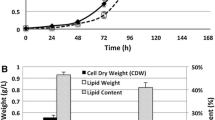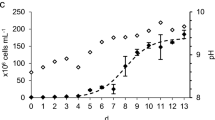Abstract
Four kinds of cells ofChlorella protothecoides, green autotrophic cells, bacterially degraded green autotrophic cells, yellow heterotrophic cells and bacterially degraded yellow heterotrophic cells, were used to simulate thermal degradation and gas formation by heating without oxygen at 300°C for 100 h. The yield of pyrolysed hydrocarbon gases in yellow heterotrophic cells with bacterial degradation was 8.5 times higher than that of green autotrophic cells without bacterial degradation. The use of bacterially degraded yellow heterotrophic cells resulted in relatively more lipid and less protein. The results suggest that the hydrocarbon-producing potential of microplanktonic algae in nature may be greater than previously thought based on studies of green autotrophic cells.
Similar content being viewed by others
References
Alexander R, Kralert PG, Kagi RI (1991) Kinetics and mechanism of the thermal decomposition of esters in sediments. Org. Geochem. 19: 133–140.
Cranwell PA (1976) Decomposition of aquatic biota, and sediment formation: organic compounds in detritus resulting from microbial attack in the algaCeratium hirundinella. Freshwat. Biol. 6: 41–48.
Derenne S, Largeau C, Hatcher PG (1992) Structure ofChlorella fusca algaenan: relationship with ultralaminae in lacustrine kerogens; species- and environment-dependent variation in the composition of fossil aultralaminae. Org. Geochem. 18: 417–422.
Fukushima K, Morinaga S, Uzaki M, Ochiai M (1989) Hydrocarbons generated by pyrolysis of insoluble kerogen-like materials isolated from microbially degraded plant residues. Chem. Geol. 76: 131–141.
Gelpi E, Schneider HJ, Mann J, Oro J (1970) Hydrocarbons of geochemical significance in microscopic algae. Phytochem. 9: 603–612.
Grant NG, Hommersand MH (1974) The respiratory chain ofChlorella protothecoides. Plant Physiol. 54: 50–56.
Holden M (1970) Chlorophyll bleaching systems in leaves. Phytochem. 9: 1771–1777.
Philip RP, Brown S, Clavin M (1978) Isoprenoid hydrocarbons produced by thermal alteration ofNostoc muscorum andRhodopseudomonas spheroides Geochim. Cosmochim. Acta 42: 63–68.
Piorreck M, Baasch KH, Pohl P (1984) Biomass production, total protein, chlorophylls, lipids and fatty acids of fresh water green and blue-green algae under different nitrogen regimes. Phytochem. 23: 207–216.
Schoell M (1983) Genetic characterization of natural gases. Am. Ass. Petroleum Geologists Bull. 67: 2225–2238.
Shifrin, NS, Chisholm SW (1981) Phytoplankton lipids: interspecific differences and effects of nitrate, silicate and light-dark cycles. J. Phycol. 17: 374–384.
Tannenbaum E, Kaplan IR (1985) Role of minerals in the thermal alternation of organic matter-I: Generation of gases and condensates under dry condition. Geochim. Cosmochim. Acta 49: 2589–2604.
Tissot BP, Welte DH (1984) Petroleum Formation and Occurrence. 2nd edn, Springer, Berlin.
Tornabene TG (1982) Microorganisms as hydrocarbon producers. Experientia 38: 43.
Vincent WF, Goldman CR (1980) Evidence for algal heterotrophy in Lake Tahoe, California-Nevada. Limnol. Oceanogr. 25: 89–99.
Wakeham SG (1990) Algal and bacterial hydrocarbons in particulate matter and interfacial sediment of the Cariaco Trench. Geochim. Cosmochim. Acta 54: 1325–1326.
Wu Q, Sheng G, Fu J (1989) Components of natural gas resulting from thermal degradation of the blue-green alga (cyanobacterium)Oscillatoria tenuis. J. appl. Phycol. 1: 285–287.
Wu Q, Kuang M, Grant NG (1992) Growth, AEC and pigments ofChlorella protothecoides in two strains under the autotrophic and heterotrophic conditions. Acta Plant Physiol. Sinica 18: 293–299.
Wu Q, Yin S, Sheng G, Fu J (1994) New discoveries in study on liquid hydrocarbons from thermal degradation of heterotrophically yellowing algae. Science in China (B) 37: 326–335.
Author information
Authors and Affiliations
Rights and permissions
About this article
Cite this article
Wu, Q., Zhang, B. & Grant, N.G. High yield of hydrocarbon gases resulting from pyrolysis of yellow heterotrophic and bacterially degradedChlorella protothecoides . J Appl Phycol 8, 181–184 (1996). https://doi.org/10.1007/BF02184969
Received:
Revised:
Accepted:
Issue Date:
DOI: https://doi.org/10.1007/BF02184969




